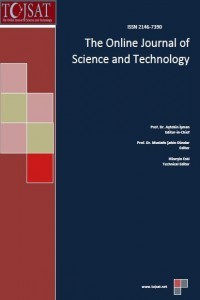REMOVAL OF FINE PARTICLES FROM WASTEWATER USING INDUCED AIR FLOTATION
REMOVAL OF FINE PARTICLES FROM WASTEWATER USING INDUCED AIR FLOTATION
___
- Bratby, J. (2006). Coagulation and Flocculation in Water and Wastewater Treatment. Published by IWA Publishing, London.
- Colic, M., Morse, W., and Miller, J.D. (2007). The development and application of centrifugal flotation systems in wastewater treatment, Int. J. Environment and Pollution, Vol. 30, No: 2, 296-312.
- Çınar, M., Şahbaz, O., Çınar, F., Kelebek, Ş. and Ötekaya, B. (2007). Effect of Jameson Cell Operating Variables and Design Characteristics on Quartz-Dodecylamine Flotation System, Minerals Engineering, 20/15, pp. 1391-1396.
- Evans, G.M., Atkinson, B.W. and Jameson, G.J. (1995). The Jameson Cell, Flotation Science and Engineering, Edited by K.A. Matis, pp 331-363. Gregory, J. (2005). Particles in water: Properties and Process,University College London.
- Jameson, G.J. (1988). A new concept in flotation column design, In: Sastry, K.V.S. (Ed.), Proceedings of the ‘‘Column Flotation 1988’’, Annual meeting, Society of Mining Engineering, Phoenix, Arizona, January 25–28, 1988.
- Jameson, G.J. (1999). Hydrophobicity and Floc Density in Induced-air Flotation for Water Treatment, Colloids Surfaces A: Physicochem. Eng. Asp, 151, pp 269-281.
- Kotze, K., Conway, C., Yan, Y., Janata, W. and Somers, B. (2001). Removal of algae and phosphate from effluent emanating from the Waihi wastewater treatment facility using an innovative new induced air flotation system, Proceeding of 2001 Joint Conference of SCENZ/FEANZ/EMG, Auckland.
- Matis, K.A. and Zouboulis, A.I. (1995). An overview of the process. 1995. Flotation Science and Engineering, Edited by K.A. Matis, pp 1-45. Odegaard, H. (2001). The Use of Dissolved Air Flotation in Municipal Wastewater Treathment, Water Science and Technology, 43 (8), pp 75-81.
- Orr, D. J. (2000). Implementation and Optimisation of a Suspended Solids Removal Solids Removal Unit, Individual Inquiry, The University of Queensland, Submitted to The Department of Chemical Enginnering.
- Rosa J.J. and Rubio J. (2005). The FF (flocculation–flotation) process, Minerals Engineering. 18, pp 701- 707.
- Rubio, J., Souzo M.L. and Smith, R.W. (2002). Overview of Flotation as a Wastewater Treatment Technique, Mineral Engineering, V 15, pp 139-155.
- Russell D. L. (2006). Practical wastewater treatment, Global Environmental Operations, Inc. Lilburn, Georgia.
- Şener, S. (2007). Removal of suspended solid materials from the wastewater of natural dimension Stone cutting plants by flocculation, Journal of Science and Technology, 1 (2), pp 234-244.
- Taşdemir, A., Taşdemir, T. and Öteyaka, B. (2007). The effect of Particle Size and Some Operating Parameters in the Separation Tank and the Downcomer on the Jameson Cell Recovery, Minerals Engineering, 20/15, pp. 1331-1336.
- Taşdemir, T. and Erdem, V. (2010). Flokülasyon yöntemi ile atıksudan askıda tanelerin giderimi, Eskişehir Osmangazi Üniversitesi Mühendislik Mimarlık Fakültesi Dergisi, Cilt/Vol:XXIII, Sayı no:1, pp:109-121.
- Tripathy, T. and Ranjan De, B. (2006). Flocculation : A New Way to Treat the Waste Water, Journal of Physical Sciences, Vol. 10, pp 93 – 127.
- Viera, A:M. and Peres, A.E.C. (2007). Effect of amine type, pH and size range in the flotation of quartz, Minerals Engineering,20, pp 1008-1013.
- Yan, Y.D. and Jameson, G.J. (2004). Application of the Jameson Cell technology for algae and phosphorus removal from maturation ponds, Int. J. Miner. Process., Vol 73, pp 23-28.
- ISSN: 2146-7390
- Başlangıç: 2011
- Yayıncı: The association of science, education and technology
REMOVAL OF FINE PARTICLES FROM WASTEWATER USING INDUCED AIR FLOTATION
Tuba TAŞDEMİR, Adem TAŞDEMİR, Yaprak GEÇGEL
INTEGRATED WATERSHED MANAGEMENT: SOCIOECONOMIC PERSPECTIVE
Mehmet KARPUZCU, Şermin DELİPINAR
NUMERICAL SIMULATING FOR RAIN-WIND INDUCED VIBRATION OF INCLINED CABLES
MACHINABILITY OF MAGNESIUM AND ITS ALLOYS
TRUCK CHASSIS STRUCTURAL THICKNESS OPTIMIZATION WITH THE HELP OF FINITE ELEMENT TECHNIQUE
